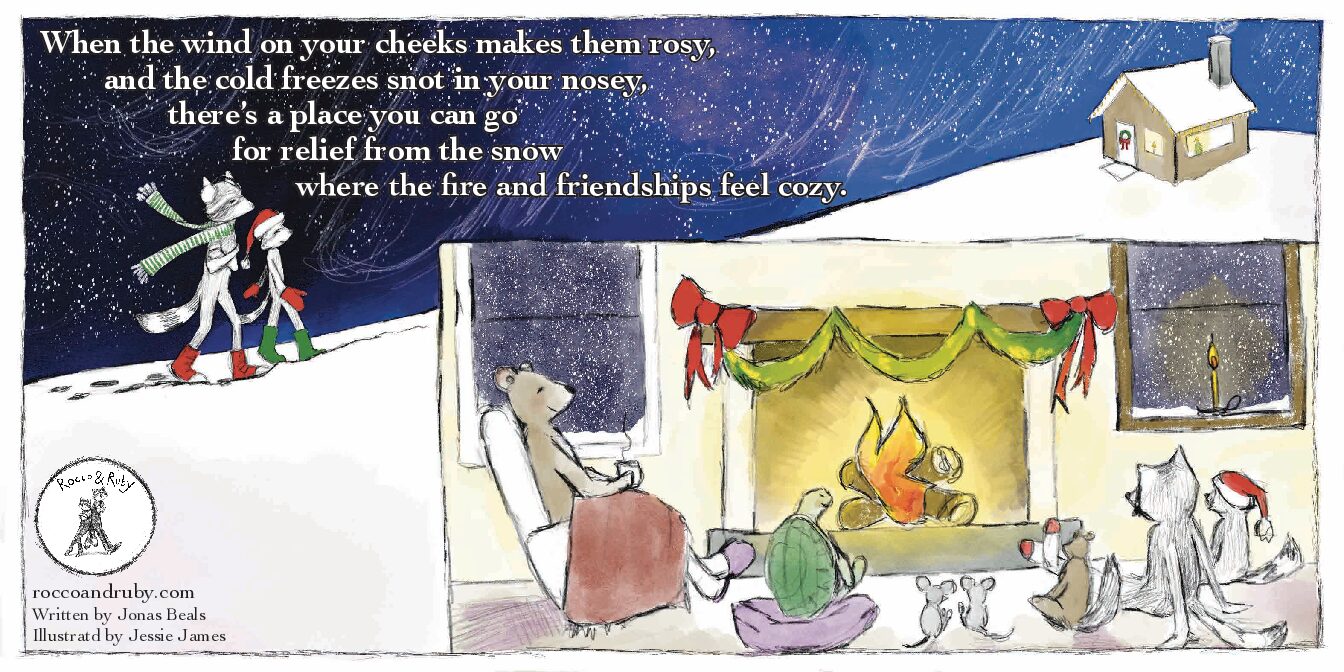
Lake Anna Weather is brought to you by Michael Eckert. To keep up to date with this storm and other weather alerts, join Lake Anna Weather here.
As central and northern Virginia brace for an approaching winter storm, residents and visitors to Lake Anna should prepare for challenging travel conditions starting Sunday evening into Monday. While the weekend begins quietly, with cold but calm weather on Saturday and Sunday, significant changes are on the horizon.
Ice Formation on Lake Anna: A Word of Caution
Cold temperatures this weekend will cause ice to form in shallower coves and upper portions of Lake Anna. However, residents are strongly advised not to venture onto the ice. Unlike typical lakes, Lake Anna’s upper portions resemble slow-moving rivers, creating areas of dangerously thin ice. In contrast, the lower portions remain warmer due to the power plant’s outflow, further complicating ice consistency. While the icy views may be picturesque, safety must remain a priority.
Snow Expected Sunday Evening
Cloud cover will increase on Sunday as the winter storm approaches, with snow anticipated to begin Sunday evening. Accumulations of 2–4 inches are expected initially, but this is only the start of a complex weather event.
The Challenge of Forecasting This Storm
Meteorological models have been inconsistent in predicting the heaviest snow’s exact location. Here’s a breakdown:
- Current Model Discrepancies:
- The North American Meso-Scale (NAM) and Global Forecast System (GFS) models now shift the axis of heaviest snow northward into northern Virginia.
- The European (EC) model has significantly shifted southward, bringing the heaviest snowfall closer to Charlottesville and Lake Anna.
- The Canadian model (CMC) remains slightly north of the GFS and NAM predictions.
- Reasons for Uncertainty:
- The storm system is still transitioning inland from the West Coast, meaning model data remains sparse.
- This is a fast-moving system, which tends to produce less snow than slower-moving storms.
- Southerly flow ahead of the storm introduces warmer air, increasing the likelihood of mixed precipitation.
- The absence of a strong Arctic high-pressure system makes it difficult to lock cold air in place.
What to Expect: A Snow and Ice Mix
Sticking with current forecasting trends, this storm is expected to deliver a mix of snow, sleet, and freezing rain:
- Sunday Evening into Early Monday: Snowfall begins with 2–4 inches of accumulation.
- Late Sunday Night/Early Monday Morning: Warmer air aloft will shift snow to sleet and freezing rain. If freezing rain dominates, expect ice coatings on trees and power lines. Sleet, however, would be a less hazardous outcome.
- Monday Morning/Afternoon: As the low-pressure system transitions to the coast, colder air may return, changing precipitation back to snow, with an additional 1–3 inches possible.
Wind Chills and Precautions
Wind chill temperatures this weekend and early next week will plunge into the teens and 20s during the day and single digits at night. Residents should take precautions to stay warm and avoid prolonged exposure to the cold.
This forecast focuses on the Lake Anna area. For those in other regions, please consult your local National Weather Service office at www.weather.gov for official updates. As conditions evolve, stay safe, stay informed, and enjoy the winter beauty responsibly.

I grew up an Air Force Brat. Traveled the country and lived in Georgia, Maine, New York, Hawaii and Oklahoma.
I fell in love with the weather in Oklahoma. My father was transferred to Tinker AFB in 1973. While in Temporary housing (a mobile home, which is the standard in Oklahoma) I experienced my first severe thunderstorm with strong winds and hail the size of baseballs. The next day I was in the base library looking up books on weather. The rest is history.
I graduated from the University of Oklahoma in 1983 with a Bachelor’s Degree in Meteorology. The first two years we took Calculus, Differential equations, Physics, Chemistry and Computer science classes with the Engineering Students. It was a grind. My degree is actually from the College of Engineering. The last 2-3 year’s focus was on Meteorology including Observational networks (Satellite, Radar, Surface), Physics, Thermodynamics, Dynamics, Synoptic, Winter Weather, Severe Weather and Climatology.
My first job out of college was with a small forecasting company in Oklahoma City. I was immediately put on TV (OETA) and Radio (WKY) as their broadcast Meteorologist. After two years in broadcasting, I decided to pursue the National Weather Service route and got a position in Toledo, OH as an intern. After a couple of years, I was promoted to a forecaster position at the Cleveland Forecast office. I quickly moved into the Weather Preparedness position and was responsible for all the preparedness activities in the state of Ohio.
In 1992 I decided to pursue other forecast opportunities and moved to the Meteorological Operations Division of the National Meteorological Center in Washington, DC. This group is now called WPC (Weather Prediction Center). There I fine-tuned my forecasting of Synoptic Weather with my focus on Heavy Convective Rainfall and Winter Storms, under the supervision of Dr. Louis Uccellini. He has written several books on East Coast Winter storms. I was promoted to a Senior Branch Forecast position during my tenure at MOD. Part of my job was to teach weather classes at COMET (Cooperative Program for Operational Meteorology, Education, and Training).
In 2012 I was given the opportunity to start up a new weather support group with the FAA (Federal Aviation Administration) in Warrenton, VA at the ATCSSC (Air Traffic Control System Command Center). The ATCSCC is where the FAA identifies solutions to air traffic inefficiencies in the NAS (National Air Space) for the CONUS (Continental United State). Weather impacts are the biggest impact on Aviation with yearly losses over 20 billion dollars. My job was to help lower these inefficiencies/costs by providing weather impact briefings and forecasts in order to keep the air planes moving as safely and efficiently as possible.
I retired in 2022 and now am running Lake Anna Weather, LLC.
Subscribe for Updates
Sponsors
latest articles
Letter from the Editor: Grateful for Our Students

New Rotary Charter Lights Up Patriotism with Flags for Heroes

Lake Anna Region Faces Moderate to Severe Drought

Powering the Lighted Boat Parade: Leaders Behind the Lights

Rocco & Ruby

Travel: Sleep in a Tugboat, Wander to Waterfalls at Lake Glen Haven

Lake Anna Weather is brought to you by Michael Eckert. To keep up to date with this storm and other weather alerts, join Lake Anna Weather here.
As central and northern Virginia brace for an approaching winter storm, residents and visitors to Lake Anna should prepare for challenging travel conditions starting Sunday evening into Monday. While the weekend begins quietly, with cold but calm weather on Saturday and Sunday, significant changes are on the horizon.
Ice Formation on Lake Anna: A Word of Caution
Cold temperatures this weekend will cause ice to form in shallower coves and upper portions of Lake Anna. However, residents are strongly advised not to venture onto the ice. Unlike typical lakes, Lake Anna’s upper portions resemble slow-moving rivers, creating areas of dangerously thin ice. In contrast, the lower portions remain warmer due to the power plant’s outflow, further complicating ice consistency. While the icy views may be picturesque, safety must remain a priority.
Snow Expected Sunday Evening
Cloud cover will increase on Sunday as the winter storm approaches, with snow anticipated to begin Sunday evening. Accumulations of 2–4 inches are expected initially, but this is only the start of a complex weather event.
The Challenge of Forecasting This Storm
Meteorological models have been inconsistent in predicting the heaviest snow’s exact location. Here’s a breakdown:
- Current Model Discrepancies:
- The North American Meso-Scale (NAM) and Global Forecast System (GFS) models now shift the axis of heaviest snow northward into northern Virginia.
- The European (EC) model has significantly shifted southward, bringing the heaviest snowfall closer to Charlottesville and Lake Anna.
- The Canadian model (CMC) remains slightly north of the GFS and NAM predictions.
- Reasons for Uncertainty:
- The storm system is still transitioning inland from the West Coast, meaning model data remains sparse.
- This is a fast-moving system, which tends to produce less snow than slower-moving storms.
- Southerly flow ahead of the storm introduces warmer air, increasing the likelihood of mixed precipitation.
- The absence of a strong Arctic high-pressure system makes it difficult to lock cold air in place.
What to Expect: A Snow and Ice Mix
Sticking with current forecasting trends, this storm is expected to deliver a mix of snow, sleet, and freezing rain:
- Sunday Evening into Early Monday: Snowfall begins with 2–4 inches of accumulation.
- Late Sunday Night/Early Monday Morning: Warmer air aloft will shift snow to sleet and freezing rain. If freezing rain dominates, expect ice coatings on trees and power lines. Sleet, however, would be a less hazardous outcome.
- Monday Morning/Afternoon: As the low-pressure system transitions to the coast, colder air may return, changing precipitation back to snow, with an additional 1–3 inches possible.
Wind Chills and Precautions
Wind chill temperatures this weekend and early next week will plunge into the teens and 20s during the day and single digits at night. Residents should take precautions to stay warm and avoid prolonged exposure to the cold.
This forecast focuses on the Lake Anna area. For those in other regions, please consult your local National Weather Service office at www.weather.gov for official updates. As conditions evolve, stay safe, stay informed, and enjoy the winter beauty responsibly.

I grew up an Air Force Brat. Traveled the country and lived in Georgia, Maine, New York, Hawaii and Oklahoma.
I fell in love with the weather in Oklahoma. My father was transferred to Tinker AFB in 1973. While in Temporary housing (a mobile home, which is the standard in Oklahoma) I experienced my first severe thunderstorm with strong winds and hail the size of baseballs. The next day I was in the base library looking up books on weather. The rest is history.
I graduated from the University of Oklahoma in 1983 with a Bachelor’s Degree in Meteorology. The first two years we took Calculus, Differential equations, Physics, Chemistry and Computer science classes with the Engineering Students. It was a grind. My degree is actually from the College of Engineering. The last 2-3 year’s focus was on Meteorology including Observational networks (Satellite, Radar, Surface), Physics, Thermodynamics, Dynamics, Synoptic, Winter Weather, Severe Weather and Climatology.
My first job out of college was with a small forecasting company in Oklahoma City. I was immediately put on TV (OETA) and Radio (WKY) as their broadcast Meteorologist. After two years in broadcasting, I decided to pursue the National Weather Service route and got a position in Toledo, OH as an intern. After a couple of years, I was promoted to a forecaster position at the Cleveland Forecast office. I quickly moved into the Weather Preparedness position and was responsible for all the preparedness activities in the state of Ohio.
In 1992 I decided to pursue other forecast opportunities and moved to the Meteorological Operations Division of the National Meteorological Center in Washington, DC. This group is now called WPC (Weather Prediction Center). There I fine-tuned my forecasting of Synoptic Weather with my focus on Heavy Convective Rainfall and Winter Storms, under the supervision of Dr. Louis Uccellini. He has written several books on East Coast Winter storms. I was promoted to a Senior Branch Forecast position during my tenure at MOD. Part of my job was to teach weather classes at COMET (Cooperative Program for Operational Meteorology, Education, and Training).
In 2012 I was given the opportunity to start up a new weather support group with the FAA (Federal Aviation Administration) in Warrenton, VA at the ATCSSC (Air Traffic Control System Command Center). The ATCSCC is where the FAA identifies solutions to air traffic inefficiencies in the NAS (National Air Space) for the CONUS (Continental United State). Weather impacts are the biggest impact on Aviation with yearly losses over 20 billion dollars. My job was to help lower these inefficiencies/costs by providing weather impact briefings and forecasts in order to keep the air planes moving as safely and efficiently as possible.
I retired in 2022 and now am running Lake Anna Weather, LLC.
Subscribe for Updates
Sponsors
latest articles
Letter from the Editor: Grateful for Our Students

New Rotary Charter Lights Up Patriotism with Flags for Heroes

Lake Anna Region Faces Moderate to Severe Drought

Powering the Lighted Boat Parade: Leaders Behind the Lights

Rocco & Ruby

Travel: Sleep in a Tugboat, Wander to Waterfalls at Lake Glen Haven

Spotsylvania Tourism Growth Outpaces Statewide Averages with 35% Surge Since 2019
Article By Jen Bailey
![Featured image for “[Spotsylvania] New Speed Enforcement in School Zones”](https://lakeanna.online/wp-content/uploads/2025/09/Blog-pic-scaled.jpg)
[Spotsylvania] New Speed Enforcement in School Zones
Article By Jen Bailey






